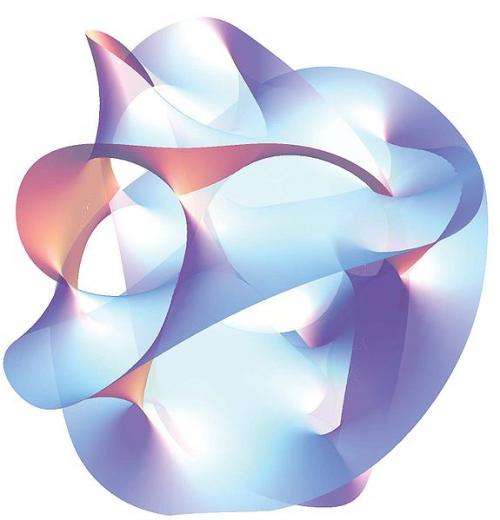Scientists find a practical test for string theory

(Phys.org) —Scientists at Towson University in Towson, Maryland, have identified a practical, yet overlooked, test of string theory based on the motions of planets, moons and asteroids, reminiscent of Galileo's famed test of gravity by dropping balls from the Tower of Pisa.
String theory is infamous as an eloquent theoretical framework to understand all forces in the universe —- a so-called "theory of everything" —- that can't be tested with current instrumentation because the energy level and size scale to see the effects of string theory are too extreme.
Yet inspired by Galileo Galilei and Isaac Newton, Towson University scientists say that precise measurements of the positions of solar-system bodies could reveal very slight discrepancies in what is predicted by the theory of general relativity and the equivalence principle, or establish new upper limits for measuring the effects of string theory.
The Towson-based team presents its finding today, January 6, 2014, between 10 a.m. and 11:30 a.m., at the 223rd meeting of the American Astronomical Society, in Washington, D.C. The work also appears in the journal Classical and Quantum Gravity.
String theory hopes to provide a bridge between two well-tested yet incompatible theories that describe all known physics: Einstein's general relativity, our reigning theory of gravity; and the standard model of particle physics, or quantum field theory, which explains all the forces other than gravity.
String theory posits that all matter and energy in the universe is composed of one-dimensional strings. These strings are thought to be a quintillion times smaller than the already infinitesimal hydrogen atom and thus too minute to detect indirectly. Similarly, finding signs of strings in a particle accelerator would require millions of times more energy than what has been needed to identify the famous Higgs boson.
"Scientists have joked about how string theory is promising...and always will be promising, for the lack of being able to test it," said Dr. James Overduin of the Department of Physics, Astronomy and Geosciences at Towson University, first author on the paper. "What we have identified is a straightforward method to detect cracks in general relativity that could be explained by string theory, with almost no strings attached."
Overduin and his group —- including Towson University undergraduate research students Jack Mitcham and Zoey Warecki —- expanded on a concept proposed by Galileo and Newton to explain gravity.
Fable has it that Galileo dropped two balls of different weights from the Tower of Pisa to demonstrate how they would hit the ground at the same time. Years later Newton realized that the same experiment is being performed by Mother Nature all the time in space, where the moons and planets of the solar system fall continuously toward each other as they orbit around their common centers of mass. Newton used telescope observations to conclude that Jupiter and its Galilean moons fall with the same acceleration toward the Sun.
The same test could be used for string theory, Overduin said. The gravitational field couples to all forms of matter and energy with precisely the same strength, an observation that led Einstein to his theory of general relativity and is now enshrined in physics as the equivalence principle. String theory predicts violations of the equivalence principle because it involves new fields which couple differently to objects of different composition, causing them to accelerate differently, even in the same gravitational field.
Building on work done by Kenneth Nordtvedt and others beginning in the 1970s, Overduin and his collaborators consider three possible signatures of equivalence principle violation in the solar system: departures from Kepler's Third Law of planetary motion; drift of the stable Lagrange points; and orbital polarization (also known as the Nordtvedt effect), whereby the distance between two bodies like the Earth and Moon oscillates due to differences in acceleration toward a third body like the Sun.
To date, there is no evidence for any of these effects. Indeed, the standard astronomical ephemeris assumes the validity of Kepler's Third Law in deriving such fundamental quantities as the length of the Astronomical Unit. But all observations in science involve some degree of experimental uncertainty. The approach of Overduin's team is to use these experimental uncertainties themselves to obtain upper limits on possible violations of the equivalence principle by the planets, moons and Trojan asteroids in the solar system.
"The Saturnian satellites Tethys and Dione make a particularly fascinating test case," said Warecki, who is presenting this work at Session 109 at the AAS meeting today. "Tethys is made almost entirely of ice, while Dione possesses a significantly rocky core. And both have Trojan companions."
"The limits obtained in this way are not as sensitive as those from dedicated torsion-balance or laser-ranging tests," said Mitcham. "But they are uniquely valuable as potential tests of string theory nonetheless because they cover a much wider range of test-body materials."
Moreover, in an era of increasingly big-budget science, they come at comparatively little cost, said Overduin.
More information: "Expanded Solar-System Limits on Violations of the Equivalence Principle," m.iopscience.iop.org/0264-9381/31/1/015001
Provided by Towson University



















